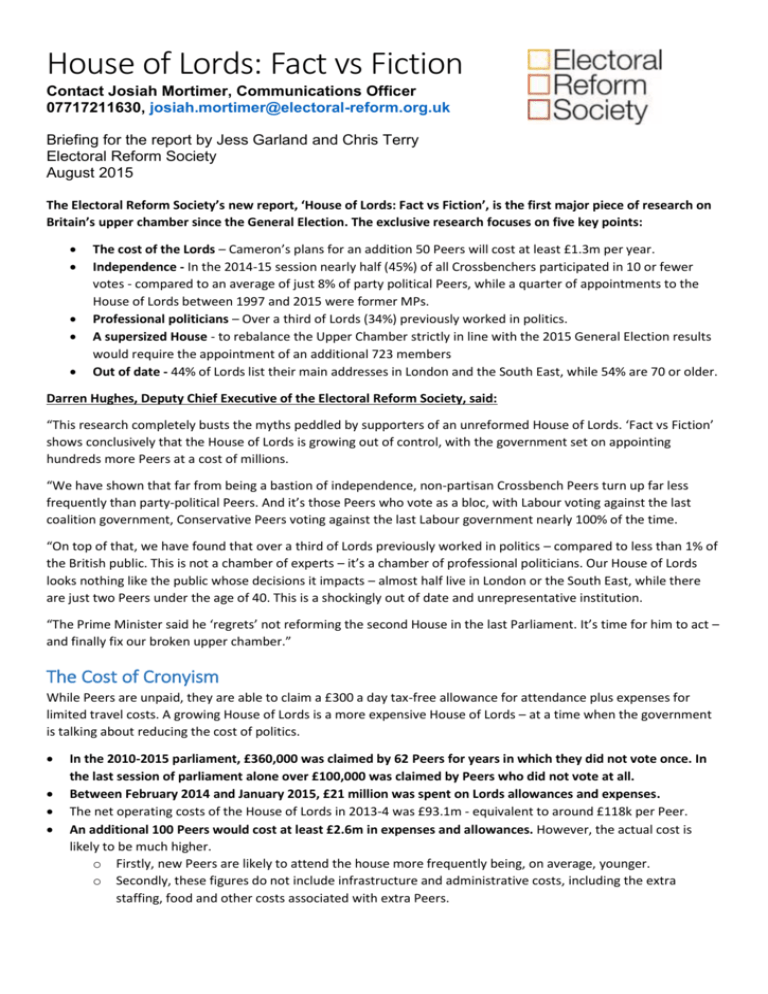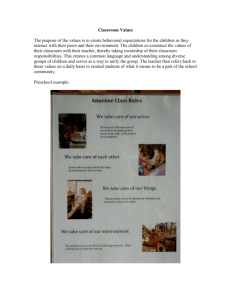House of Lords: Fact vs Fiction
advertisement

House of Lords: Fact vs Fiction Contact Josiah Mortimer, Communications Officer 07717211630, josiah.mortimer@electoral-reform.org.uk Briefing for the report by Jess Garland and Chris Terry Electoral Reform Society August 2015 The Electoral Reform Society’s new report, ‘House of Lords: Fact vs Fiction’, is the first major piece of research on Britain’s upper chamber since the General Election. The exclusive research focuses on five key points: The cost of the Lords – Cameron’s plans for an addition 50 Peers will cost at least £1.3m per year. Independence - In the 2014-15 session nearly half (45%) of all Crossbenchers participated in 10 or fewer votes - compared to an average of just 8% of party political Peers, while a quarter of appointments to the House of Lords between 1997 and 2015 were former MPs. Professional politicians – Over a third of Lords (34%) previously worked in politics. A supersized House - to rebalance the Upper Chamber strictly in line with the 2015 General Election results would require the appointment of an additional 723 members Out of date - 44% of Lords list their main addresses in London and the South East, while 54% are 70 or older. Darren Hughes, Deputy Chief Executive of the Electoral Reform Society, said: “This research completely busts the myths peddled by supporters of an unreformed House of Lords. ‘Fact vs Fiction’ shows conclusively that the House of Lords is growing out of control, with the government set on appointing hundreds more Peers at a cost of millions. “We have shown that far from being a bastion of independence, non-partisan Crossbench Peers turn up far less frequently than party-political Peers. And it’s those Peers who vote as a bloc, with Labour voting against the last coalition government, Conservative Peers voting against the last Labour government nearly 100% of the time. “On top of that, we have found that over a third of Lords previously worked in politics – compared to less than 1% of the British public. This is not a chamber of experts – it’s a chamber of professional politicians. Our House of Lords looks nothing like the public whose decisions it impacts – almost half live in London or the South East, while there are just two Peers under the age of 40. This is a shockingly out of date and unrepresentative institution. “The Prime Minister said he ‘regrets’ not reforming the second House in the last Parliament. It’s time for him to act – and finally fix our broken upper chamber.” The Cost of Cronyism While Peers are unpaid, they are able to claim a £300 a day tax-free allowance for attendance plus expenses for limited travel costs. A growing House of Lords is a more expensive House of Lords – at a time when the government is talking about reducing the cost of politics. In the 2010-2015 parliament, £360,000 was claimed by 62 Peers for years in which they did not vote once. In the last session of parliament alone over £100,000 was claimed by Peers who did not vote at all. Between February 2014 and January 2015, £21 million was spent on Lords allowances and expenses. The net operating costs of the House of Lords in 2013-4 was £93.1m - equivalent to around £118k per Peer. An additional 100 Peers would cost at least £2.6m in expenses and allowances. However, the actual cost is likely to be much higher. o Firstly, new Peers are likely to attend the house more frequently being, on average, younger. o Secondly, these figures do not include infrastructure and administrative costs, including the extra staffing, food and other costs associated with extra Peers. Party over principle? Independence in the Lords Supporters of an unreformed Lords often claim that the role of independent Crossbenchers means that it serves as an impartial and expert revising chamber. Yet our research shows that partisan Peers turn up far more frequently than independent ones - and that party Peers vote as a bloc. A quarter of appointments to the House of Lords between May 1997 and March 2015 were former MPs. 71% of Peers take a party whip (556 out of 782). Crossbenchers account for less than a quarter of the membership of the Upper Chamber (23%). For the last 20 years the size of the Crossbench group has never exceeded 30% of the house. In the 2014-15 session nearly half (45%) of all Crossbenchers participated in 10 or fewer votes - compared to an average of just 8% of party political Peers. Average attendance for Crossbencher Peers is just 42%, while average attendance for political Peers is 67%. Average division (voting) participation for Crossbench Peers is 16%, compared to average voting participation for political Peers which is 47%. Partisan Peers, put simply, vote much more frequently than independent Lords. Partisan Peers aren’t independent – they vote en bloc. Between 1999 and 2009, Conservative Peers voted against the Labour government in an average of 97% of votes in whipped divisions. Labour Peers voted against the coalition government in 99% of whipped division between 2010 and 2015. Experts – or Professional Politicians? Professional experience amongst members of the House of Lords is concentrated in the field of electoral politics - it is the single most common background for Peers. Twenty-seven percent (27%) of Peers have politics as their primary or secondary profession – a further 7 percent are former political staff, activists or held official positions in political parties. This means that over a third (34%) of Lords worked in politics. The next highest is business and commerce (9%) then legal professions (7%) then banking and finance (6%). Manual and skilled trades, policing, and transport are represented by 1% or less of the chamber each. Two Peers worked primarily as part of the royal household – compared to one Peer from a manual background. A Supersized Second House The House of Lords is the second largest legislative chamber in the world – after China. Yet the Prime Minister is expected to appoint a further 50 or so over the summer. This will only do further damage to our democracy: There are currently 132 more unelected lawmakers than elected ones – a ratio of 1 to 1.2. This is expected to grow significantly following the government’s cutting of the size of the Commons to 600 MPs. Our calculations show that to rebalance the Upper Chamber strictly in line with the 2015 General Election results would require the appointment of an additional 723 members, bringing the total House to 1545, and the ratio of elected to unelected Peers across Parliament to 1:2.37. If the principle of party balance was based on Commons seat share rather than vote share (as David Cameron suggests it should), a staggering 7861 additional Peers would be needed to bring the House of Lords in line with the 2015 General Election results. Unrepresentative and Unfit for Purpose It’s sometimes claimed that because Peers are appointed, the upper chamber can make up for the Commons’ lack of demographic representativeness. But the Lords is even less reflective of the UK’s diversity than our elected chamber: There are five times as many Peers over 60 than under 60; Over half (54%) of the total membership is 70 or over, while only two members are under 39 years old. 44% of Lords list their main addresses in London and the South East Despite Prime Ministers having power over appointments, just over a quarter of appointments made between May 1997 and March 2015 were women (27%/161 women). 1006 party political appointments have been made since 1958: only 219 of these (22%) have been women.






